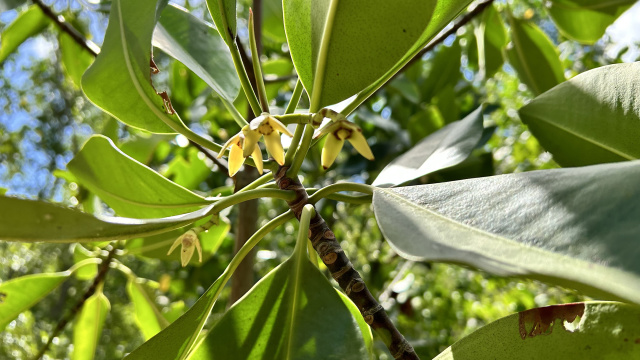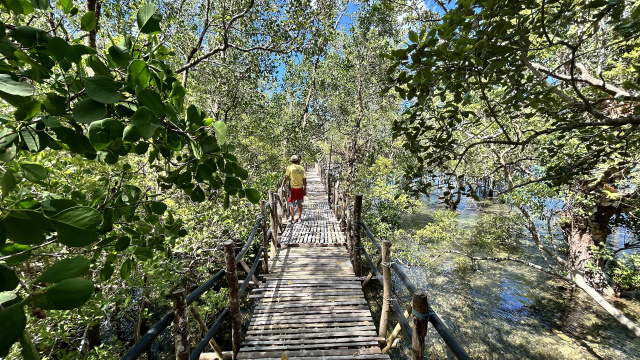Life on Earth •
Forests •
Conservation •
Kuno Foundation •
Empowering Collective Impact •
Panay Island
Stewards of Nature: a couple's commitment to Pagatpat Mangrove Park
Panay Island
In the coastal village of Brgy. Panilongan in Buruanga, Aklan, on the island of Panay, a sprightly couple in their 70s has dedicated themselves to preserving and nurturing the Pagatpat Mangrove Park. Emil Prado, 75, and Julia Prado, 71, have become proactive stewards of their community's mangrove forest, with a mission to protect and regrow this vital ecosystem.

Passionate Custodians
Emil and Julia Prado are not only custodians of the mangrove forest but also passionate advocates for environmental education. They have taken it upon themselves to showcase the remaining mangrove cover and actively support its regrowth. Their self-initiated activities include educating local community members and opening the park for educational purposes to visitors.
The couple believes in an intergenerational cycle of exchange. They engage community youth and children in volunteer work to clean and maintain the mangrove site, fostering a sense of responsibility and environmental stewardship in the next generation.
Learning about the pagatpat mangrove is crucial for its important role:
Sonneratia alba, commonly known as the mangrove apple or pagatpat, is a mangrove species found in coastal and estuarine environments throughout the Indo-Pacific region. This resilient tree is notable for its role in stabilizing shorelines and providing crucial habitats for various marine and bird species. Sonneratia alba features a unique conical fruit and white flowers that open at night, attracting pollinators like bats and moths. It is vital for coastal protection, mitigating erosion, and supporting biodiversity in mangrove ecosystems.

A Collaborative Effort
The project began with the support of a Peace Corps Volunteer working on a Coastal Resource Management project in Buruanga. This volunteer was instrumental in organizing and planning the mangrove park, bringing valuable resources and support to the Prados' vision.
Ecological and Community Impact
Today, the Pagatpat Mangrove Park serves as a crucial support system for marine habitats and a spawning ground for various species. It also provides shoreline protection during storms. Recognized in municipal tourism promotions as an eco-tourism site, the park has brought a sense of pride to both Emil and Julia Prado.
Their dedication not only preserves an essential part of the coastal ecosystem but also inspires their community, highlighting the significant impact that committed individuals can have on environmental conservation.


Raz Salvarita
In the coastal village of Brgy. Panilongan in Buruanga, Aklan, on the island of Panay, a sprightly couple in their 70s has dedicated themselves to preserving and nurturing the Pagatpat Mangrove Park. Emil Prado, 75, and Julia Prado, 71, have become proactive stewards of their community's mangrove forest, with a mission to protect and regrow this vital ecosystem.

Passionate Custodians
Emil and Julia Prado are not only custodians of the mangrove forest but also passionate advocates for environmental education. They have taken it upon themselves to showcase the remaining mangrove cover and actively support its regrowth. Their self-initiated activities include educating local community members and opening the park for educational purposes to visitors.
The couple believes in an intergenerational cycle of exchange. They engage community youth and children in volunteer work to clean and maintain the mangrove site, fostering a sense of responsibility and environmental stewardship in the next generation.
Learning about the pagatpat mangrove is crucial for its important role:
Sonneratia alba, commonly known as the mangrove apple or pagatpat, is a mangrove species found in coastal and estuarine environments throughout the Indo-Pacific region. This resilient tree is notable for its role in stabilizing shorelines and providing crucial habitats for various marine and bird species. Sonneratia alba features a unique conical fruit and white flowers that open at night, attracting pollinators like bats and moths. It is vital for coastal protection, mitigating erosion, and supporting biodiversity in mangrove ecosystems.

A Collaborative Effort
The project began with the support of a Peace Corps Volunteer working on a Coastal Resource Management project in Buruanga. This volunteer was instrumental in organizing and planning the mangrove park, bringing valuable resources and support to the Prados' vision.
Ecological and Community Impact
Today, the Pagatpat Mangrove Park serves as a crucial support system for marine habitats and a spawning ground for various species. It also provides shoreline protection during storms. Recognized in municipal tourism promotions as an eco-tourism site, the park has brought a sense of pride to both Emil and Julia Prado.
Their dedication not only preserves an essential part of the coastal ecosystem but also inspires their community, highlighting the significant impact that committed individuals can have on environmental conservation.

You might like...

Rufous-headed Hornbill: A flagship species for conservation action

Embracing Ecotourism in Sibalom Natural Park

Tubbataha Reef

Guardians of the Forest
Newsletter
Sign up to keep in touch with articles, updates, events or news from Kuno, your platform for nature
